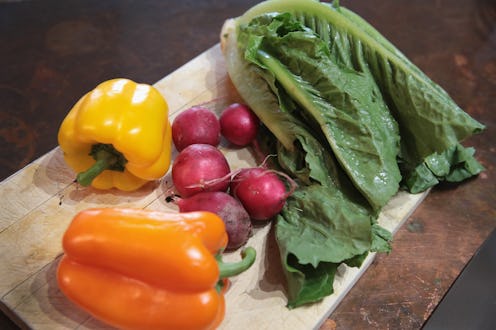Life
You Should Be Eating These 7 Gross-Looking Foods

With social media these days, we have been trained to believe that the prettier our food, the tastier it is. If the smoothie bowl is loaded with color, or if that kale salad is sprinkled with toppings, it must taste good. Although oftentimes colorful food is filled with nutrients, there are plenty of ugly foods that not only taste delicious, but are healthy. I mean, we have always been taught not to judge a book by its cover, haven't we?
"In the American supermarket, pretty food is less nutritious," says Chef Michael Hung of Viviane Restaurant to Bustle over email. "The reason is that in our age of industrial farming, fruits and vegetables have been raised with aesthetics in mind, over nutrition or flavor. For instance, really great tomatoes, in terms of flavor, color, and texture, are often ugly. They have scars, variegated colors, and tumor-like shapes."
Food isn't always aesthetically-pleasing, and sometimes nature's ugliest creations can pack the most nutritional punch, so there's no need to skip over something with an unattractive bumpy color just because it's not quite eye candy. Next time you come across these seven ugly but healthy foods at the grocery store, take a step out of your comfort zone and give these neglected foods a try.
1. Jerusalem Artichokes
"Even though Jerusalem artichokes look more like rocks than root vegetables, they're packed with nutritional benefits," says Nutritionist Jennie Miremadi to Bustle over email. "They're loaded with the prebiotic inulin, which serves as a food source for beneficial probiotic bacteria found in your gut, and they're also a good source of thiamin and potassium. "
2. Prunes
Although prunes may make you think of your grandmother, these dried plums can help aid digestion, help build strong bones and muscles, and protect against free-radical damage. They are naturally sweet, making them a good snack or addition to baking.
3. Fiddleheads
"Fiddleheads are fronds from young fern plants," says Miremadi. "Although they look like little green snails, they have a taste similar to asparagus and they are rich in vitamins A and C, niacin and potassium."
4. Oysters
"Oysters are grayish, slimy and very oddly shaped," says Rene Ficek, RD over email. "However, they are low in calories and one of the best sources of zinc available." The tasty seafood is also filled with protein, selenium, and iron.
5. Celeriac
"Celery root, also known as celeriac, is a knobby-shaped bulb that often has smaller, spider-like root protrusions," says Ficek. "Although gross looking, it is an excellent source of vitamin K and a good source of dietary fiber."
6. Jackfruit
Indigenous to India, Bangladesh, Philippines, and Sri Lanka, the jackfruit is an odd looking fruit that is a great source of dietary fiber, minerals, and vitamins A and C, according to Ficek. "It has a juicy pulp around the seeds that taste a lot like pineapple," Ficek says.
7. Kimchi
"Pickled and fermented cabbage, spiced to perfection, is the national dish of Korea" says Ficek. Although it may look slimy and oddly colored, kimchi contains healthy probiotics that help aid in digestion.
Who says looks are everything, anyway?